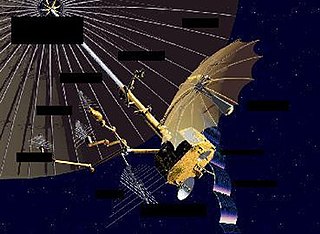Orion (satellite)
Class of United States spy satellites From Wikipedia, the free encyclopedia
Orion, also known as Mentor or Advanced Orion,[1] is a class of United States spy satellites that collect signals intelligence (SIGINT) from space. Operated by the National Reconnaissance Office (NRO) and developed with input from the Central Intelligence Agency (CIA), eight have been launched from Cape Canaveral on Titan IV and Delta IV launch vehicles since 1995.

Description
Summarize
Perspective
These satellites at geostationary orbits collect radio emissions (SIGINT) and act as replacements for the older constellation of Magnum satellites. The satellites have estimated mass close to 5,200 kg and very large (estimated 100 m diameter)[2] radio reflecting dishes. USA-223 (NROL-32), which is seen as the fifth satellite in the series, is according to NRO director Bruce Carlson "the largest satellite in the world."[3] It is believed that this refers to the diameter of the main antenna, which might be well in excess of 100 m (330 ft).[4] The mission and capabilities of these satellites are highly classified, though targets may include telemetry, VHF radio, cellular mobile phones, paging signals, and mobile data links.[5] Earlier satellites with similar missions, the Rhyolite/Aquacade series, were built by TRW; it is not known who made the Orion satellites.[6]
- USA-202 shows up as a magnitude +8 "star" in this image. Note how the real stars are trailed in this 10-second exposure: the geostationary satellite is pinpoint.
- USA-223 (NROL-32), the fifth "Mentor" satellite, atop a Delta IV rocket
- USA-202 and the nearby commercial geostationary satellite Thuraya 2
Satellites
Summarize
Perspective
Mentor-4 (USA-202) deployment and initial westward drift after launch in January 2009 was controlled by the Pine Gap base. About 60 days after launch Menwith Hill Ground Station was to take over control and initiate the collection mission. Mentor-4's initial mission was to survey line-of-sight microwave towers and emitters in the People's Republic of China for 30 to 45 days as it was drifting from east to west. Moving further west, it was to collect data from the Thuraya network and monitor Pakistan and Afghanistan, followed by another 200 days of monitoring of China. This was to be followed by data collection covering the Middle East, Northern Africa, and Latin America.[7][8]
| Name | COSPAR ID | Launch date (UTC) |
Launch vehicle | Launch site | Launch designation |
Longitude | Remarks |
|---|---|---|---|---|---|---|---|
| USA-110 | 1995-022A | 14 May 1995 13:45:01[1] | Titan IV(401)A | CCSFS, SLC-40 | N/A | 127° E [4] | MENTOR 1 |
| USA-139 | 1998-029A | 9 May 1998 01:38:01[1] | Titan IV(401)B | CCSFS, SLC-40 | NROL-6 | 44° E (1998–2009) 14.5°W (2009–) [4] | MENTOR 2 |
| USA-171 | 2003-041A | 9 September 2003 04:29:00[1] | Titan IV(401)B | CCSFS, SLC-40 | NROL-19 | 95.5° E [4] | MENTOR 3 |
| USA-202 | 2009-001A | 18 January 2009 02:47:00[1] | Delta IV Heavy | CCSFS, SLC-37B | NROL-26 | 44° E [4] | MENTOR 4 |
| USA-223 | 2010-063A | 21 November 2010 22:58:00[1] | Delta IV Heavy | CCSFS, SLC-37B | NROL-32 | 100.9° E [9] | MENTOR 5 |
| USA-237 | 2012-034A | 29 June 2012 13:15:00[1] | Delta IV Heavy | CCSFS, SLC-37B | NROL-15 | 89.21° E [10] | MENTOR 6 |
| USA-268 | 2016-036A | 11 June 2016 17:51:00[1] | Delta IV Heavy | CCSFS, SLC-37B | NROL-37 | 104.18° E [10] | MENTOR 7 |
| USA-311 | 2020-095A | 11 December 2020 01:09[11] | Delta IV Heavy | CCSFS, SLC-37B | NROL-44 | 51° E[12] | MENTOR 8 |
| USA-345 | 2023-089A | 22 June 2023 09:18[13] | Delta IV Heavy | CCSFS, SLC-37B | NROL-68 | MENTOR 9 | |
| USA-353 | 2024-067A | 9 April 2024
16:53[14] |
Delta IV Heavy | CCSFS, SLC-37B | NROL-70 |
References
External links
Wikiwand - on
Seamless Wikipedia browsing. On steroids.



